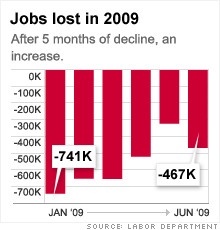Where's the beef in this rally?
Something is missing from the round of 'strong' earnings results. What is it? Oh yeah. Sales! Companies can't cost cut their way to prosperity forever.


NEW YORK (CNNMoney.com) -- I want to believe that this earnings-fueled stock rally of the past few weeks is for real. But when you look more closely at corporate results, you have to scratch your head and wonder -- just like the old lady in the famous Wendy's commercials from the 1980s -- where's the beef?
In this case, "the beef" is sales growth. Companies are reporting decent profits, but many have done so only because they've taken a chainsaw to costs.
According to figures from Thomson Baseline, the average revenue decline for companies in the S&P 500 during the past quarter was 7.5% from a year ago.
Sure, you've got some companies that have managed to grow their top and bottom lines. Apple's (AAPL, Fortune 500) sales and profit were both up sharply. Ditto for Goldman Sachs (GS, Fortune 500).
But the bigger trend in second-quarter results was exemplified by companies such as IBM (IBM, Fortune 500), McDonald's (MCD, Fortune 500) and Starbucks (SBUX, Fortune 500). Their profits increased, but their revenues were down.
The rest of the year isn't looking too pretty, either. Revenues for S&P 500 companies are expected to drop 9.5% from a year ago in the current quarter. For the full year, sales are expected to be down 5%.
Now don't get me wrong, every company should take a close look at their expenses and find areas that they can pare back. Businesses that had bloated cost structures before the recession should be able to easily juice their earnings by trimming fat. And any recovery in profits has to start somewhere.
Talkback: Have companies gone too far with layoffs? Are there other areas where they should cut costs? Leave your comments at the bottom of this story.
But at some point, investors may tire of the cost-cutting story -- even though they currently appear content to cheer positive earnings surprises any way they can get them.
"Stocks could continue to rally because of how far down they were earlier this year, but eventually you're going to need an increase in demand and sales," said Mark Oelschlager, manager of the Red Oak Technology fund.
Such demand may be hard to come by though. That's because one of the most notable sources of cost cutting this year for Corporate America are payrolls. People.
The wave of layoffs has pushed the unemployment rate to 9.5%, a 26-year high. And it's almost certain that the jobless rate will rise into the double digits before long. That's going to make it tougher for companies to keep beating profit expectations.
People can talk all they want about how unemployment is a lagging indicator, meaning that the economy will resume growing even while people are still losing their jobs.
That may be true. But the recovery may very well be muted. As long as consumers, who've been busy saving more in the past few months, keep losing their jobs or remain worried about their job security, they are likely to save more and not spend.
"It's a positive that cost cutting has stabilized the situation for many companies. But if you have high unemployment, that could keep consumer spending depressed." said Subodh Kumar, an independent market strategist with Subodh Kumar & Associates in Toronto
That may just exacerbate the problem that corporations are facing right now. Businesses won't feel the need to hire more people, invest in new growth opportunities and produce more stuff. So the "recovery" may not feel like much of a recovery. And that's something that investors need to think about.
"It's going to take time for demand to normal levels. We need the unemployment rate to stop rising. Eventually it will but it could be awhile before we see the job market snap back," Oelschlager said.
Plus, companies can only slash costs for so long. The goal of any business is to generate sales by providing consumers a product or service that they need or want. If companies keep cutting workers and holding off on investing in themselves, the quality of product or services they sell will eventually suffer.
"There is a growing school of thought that after last September, big corporate CEOs and small business owners were caught like deer in the headlights by the dysfunctional credit markets. Perhaps they cut too much," said Quincy Krosby, a market strategist with Prudential Financial.
"When you are in a downturn, it's difficult to believe you will ever get out of it. But in the past companies that continue to focus on research and development are better prepared for recoveries," she added.
The good news is that most companies have probably cut costs by such a vast degree already that they should be able to easily post very strong increases in profits once sales do rebound.
"Businesses are doing what they need to do in order to manage their bottom line. So when revenue growth does pick up, it should flow straight to the bottom line," Krosby said.
But the problem is that it may take a lot longer for sales to pick up than investors might be expecting.
"The revenue declines are unprecedented," Kumar said. "You're not going to see any revenue growth until 2010, and probably won't see a return to normal sales growth until 2011."
Talkback: Have companies gone too far with layoffs? Are there other areas where they should cut costs instead? ![]()

